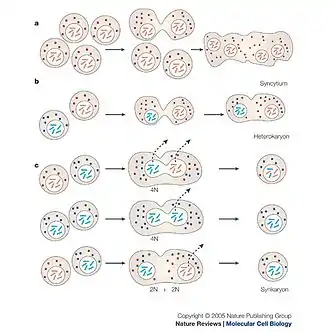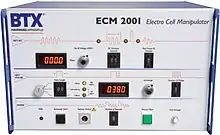Cell fusion
Cell fusion is an important cellular process in which several uninuclear cells (cells with a single nucleus) combine to form a multinuclear cell, known as a syncytium. Cell fusion occurs during differentiation of muscle, bone and trophoblast cells, during embryogenesis, and during morphogenesis.[1] Cell fusion is a necessary event in the maturation of cells so that they maintain their specific functions throughout growth.
History
In 1847 Theodore Schwann expanded upon the theory that all living organisms are composed of cells when he added to it that discrete cells are the basis of life. Schwann observed that in certain cells the walls and cavities of the cells coalesce together. It was this observation that provided the first hint that cells fuse. It was not until 1960 that cell biologists deliberately fused cells for the first time. To fuse the cells, biologists combined isolated mouse cells, with the same kind of tissue, and induced fusion of their outer membrane using the Sendai virus (a respiratory virus in mice). Each of the fused hybrid cells contained a single nucleus with chromosomes from both fusion partners. Synkaryon became the name of this type of cell combined with a nucleus. In the late 1960s biologists successfully fused cells of different types and from different species. The hybrid products of these fusions, heterokaryon, were hybrids that maintained two or more separate nuclei. This work was headed by Henry Harris at the University of Oxford and Nils Ringertz from Sweden's Karolinska Institute. These two men are responsible for reviving the interest of cell fusion. The hybrid cells interested biologists in the area of how different kinds of cytoplasm affect different kinds of nuclei. The work conducted by Henry and Nils showed that proteins from one gene fusion affect gene expression in the other partner's nucleus, and vice versa. These hybrid cells that were created were considered forced exceptions to normal cellular integrity and it was not until 2002 that the possibility of cell fusion between cells of different types may have a real function in mammals.[2]
Two types

b Cells of different lineage fuse to form a cell with multiple nuclei, known as a heterokaryon. The fused cells might have undergone a reversion of phenotype or show transdifferentiation.
c Cells of different lineage or the same lineage fuse to form a cell with a single nucleus, known as a synkaryon. New functions of the fused cell can include a reversion of phenotype, transdifferentiation and proliferation. If nuclear fusion occurs, the fused nucleus initially contains the complete chromosomal content of both fusion partners (4N), but ultimately chromosomes are lost and/or re-sorted (see arrows). If nuclear fusion does not occur, a heterokaryon (or syncytium) can become a synkaryon by shedding an entire nucleus.
There are two different types of cell fusion that can occur. These two types include homotypic and heterotypic cell fusion.
Homotypic cell fusion occurs between cells of the same type. An example of this would be osteoclasts or myofibers being fusing together with their respective type of cells. Whenever the two nuclei merge a synkaryon is produced. Cell fusion normally occurs with nuclear fusion, but in the absence of nuclear fusion, the cell would be described as a binucleated heterokaryon. A heterokaryon is the melding of two or more cells into one and it may reproduce itself for several generations.[3] If two of the same type of cells fuse, but their nuclei do not fuse, then the resulting cell is called a syncytium.[4]
Heterotypic cell fusion occurs between cells of different types, making it the exact opposite of homotypic cell fusion. The result of this fusion is also a synkaryon produced by the merging of the nuclei, and a binucleated heterokaryon in the absence of nuclear fusion. An example of this would be Bone Marrow Derived Cells (BMDCs) being fused with parenchymatous organs.[5]
Four methods
There are four methods that cell biologists and biophysicists use to fuse cells. These four ways include electrical cell fusion, polyethylene glycol cell fusion, and sendai virus induced cell fusion and a newly developed method termed optically controlled thermoplasmonics.

Electrical cell fusion is an essential step in some of the most innovative methods in modern biology. This method begins when two cells are brought into contact by dielectrophoresis. Dielectrophoresis uses a high frequency alternating current, unlike electrophoresis in which a direct current is applied. Once the cells are brought together, a pulsed voltage is applied. The pulse voltage causes the cell membrane to permeate and subsequent combining of the membranes and the cells then fuse. After this, alternative voltage is applied for a brief period of time to stabilize the process. The result of this is that the cytoplasm has mixed together and the cell membrane has completely fused. All that remains separate is the nuclei, which will fuse at a later time within the cell, making the result a heterokaryon cell.[6]
Polyethylene glycol cell fusion is the simplest, but most toxic, way to fuse cells. In this type of cell fusion polyethylene glycol, PEG, acts as a dehydrating agent and fuses not only plasma membranes but also intracellular membranes. This leads to cell fusion since PEG induces cell agglutination and cell-to-cell contact. Though this type of cell fusion is the most widely used, it still has downfalls. Oftentimes PEG can cause uncontrollable fusion of multiple cells, leading to the appearance of giant polykaryons. Also, standard PEG cell fusion is poorly reproducible and different types of cells have various fusion susceptibilities. This type of cell fusion is widely used for the production of somatic cell hybrids and for nuclear transfer in mammalian cloning.[7]
Sendai virus induced cell fusion occurs in four different temperature stages. During the first stage, which lasts no longer than 10 minutes, viral adsorption takes place and the adsorbed virus can be inhibited by viral antibodies. The second stage, which is 20 minutes, is pH dependent and an addition of viral antiserum can still inhibit ultimate fusion. In the third, antibody-refractory stage, viral envelope constituents remain detectable on the surface of cells. During the fourth stage, cell fusion becomes evident and HA neuraminidase and fusion factor begin to disappear. The first and second stages are the only two that are pH dependent.[8]
Thermoplasmonics induced cell fusion Thermoplasmonics is based on a near infrared (NIR) laser and a plasmonic nanoparticle. The laser which typically acts as an optical trap, is used to heat the nanoscopic plasmonic particle to very high and extremely locally elevated temperatures. Optical trapping of such a nanoheater at the interface between two membrane vesicles, or two cells, leads to immediate fusion of the two verified by both content and lipid mixing. Advantages include full flexibility of which cells to fuse and fusion can be performed in any buffer condition unlike electroformation which is affected by salt.
In human therapy
Alternative forms of restoring organ function and replacing damaged cells are needed with donor organs and tissue for transplantation being so scarce. It is because of the scarcity that biologists have begun considering the potential for therapeutic cell fusion. Biologists have been discussing implications of the observation that cell fusion can occur with restorative effects following tissue damage or cell transplantation. Though using cell fusion for this is being talked about and worked on, there are still many challenges those who wish to implement cell fusion as a therapeutic tool face. These challenges include choosing the best cells to use for the reparative fusion, determining the best way to introduce the chosen cells into the desired tissue, discovering methods to increase the incidence in cell fusion, and ensuring that the resulting fusion products will function properly. If these challenges can be overcome then cell fusion may have therapeutic potential.[9]
Microorganisms
Fungi
Plasmogamy is the stage of the sexual cycle of fungi in which two cells fuse together to share a common cytoplasm while bringing haploid nuclei from both partners together in the same cell.
Amoebozoa
Cell fusion (plasmogamy or syngamy) is a stage in the Amoebozoa sexual cycle.[10]
Bacteria
In Escherichia coli spontaneous zygogenesis (Z-mating) involves cell fusion, and appears to be a form of true sexuality in prokaryotes. Bacteria that perform Z-mating are called Szp+.[11]
Other uses
- To study the control of cell division and gene expression.
- To Investigate malignant transformations.
- To obtain viral replication.
- For gene and chromosome mapping.
- For production of monoclonal antibodies by producing hybridoma.
- For production of Induced stem cells.
- To assess protein shuttling in what is known as a heterokaryon fusion assay.[12]
See also
References
- "6.3. Cell fusion". Herkules.oulu.fi. Retrieved 2013-08-16.
- Ogle, Brenda M.; Platt, Jeffrey L. (1 January 2004). "The Biology of Cell Fusion: Cells of different types and from different species can fuse, potentially transferring disease, repairing tissues and taking part in development". American Scientist. 92 (5): 420–427. doi:10.1511/2004.49.943. JSTOR 27858450.
- "Definition of Cell fusion".
- Ogle, B. M.; Cascalho, M.; Platt, J. L. (2005). "Cells derived by fusion". Nature Reviews Molecular Cell Biology. 6 (7): 567–575. doi:10.1038/nrm1678. PMID 15957005.
- Singec, Ilyas; Snyder, Evan Y. (2008). "Inflammation as a matchmaker: Revisiting cell fusion". Nature Cell Biology. 10 (5): 503–505. doi:10.1038/ncb0508-503. PMID 18454127.
- "Principles And Applications Of Electrical Cell Fusion".
- Pedrazzoli, Filippo; Chrysantzas, Iraklis; Dezzani, Luca; Rosti, Vittorio; Vincitorio, Massimo; Sitar, Giammaria (1 January 2011). "Cell fusion in tumor progression: the isolation of cell fusion products by physical methods". Cancer Cell International. 11: 32. doi:10.1186/1475-2867-11-32. PMC 3187729. PMID 21933375.
- Wainberg, M. A.; Howe, C. (1 October 1973). "Factors Affecting Cell Fusion Induced by Sendai Virus". J Virol. 12 (4): 937–939. doi:10.1128/JVI.12.4.937-939.1973. PMC 356713. PMID 4359961.
- Sullivan, Stephen; Eggan, Kevin (1 January 2006). "The potential of cell fusion for human therapy". Stem Cell Rev. 2 (4): 341–349. doi:10.1007/BF02698061. PMID 17848721.
- Hofstatter PG, Brown MW, Lahr DJG (November 2018). "Comparative Genomics Supports Sex and Meiosis in Diverse Amoebozoa". Genome Biol Evol. 10 (11): 3118–3128. doi:10.1093/gbe/evy241. PMC 6263441. PMID 30380054.
- Gratia JP, Thiry M (September 2003). "Spontaneous zygogenesis in Escherichia coli, a form of true sexuality in prokaryotes". Microbiology (Reading, Engl.). 149 (Pt 9): 2571–84. doi:10.1099/mic.0.26348-0. PMID 12949181.
- Gammal, Roseann; Baker, Krista; Heilman, Destin (2011). "Heterokaryon Technique for Analysis of Cell Type-specific Localization". Journal of Visualized Experiments (49): 2488. doi:10.3791/2488. ISSN 1940-087X. PMC 3197295. PMID 21445034.
Further reading
| Library resources about Cell fusion |
- H. Harris: Cell fusion, 1970, Harvard University Press, Mass.
- Gordon, S (1975). "Cell fusion and some subcellular properties of heterokaryons and hybrids". The Journal of Cell Biology. 67 (2): 257–280. doi:10.1083/jcb.67.2.257. PMC 2109606. PMID 1104638.